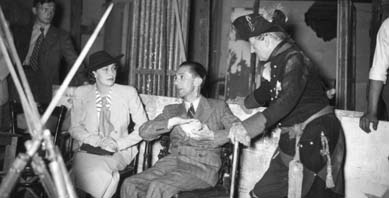Scholarship on National-Socialist Film – the 1950s to 1970s
How are we to deal with this National-Socialist film legacy? Immediately after the war, the allied military governments established a clear position with their criteria catalogue. Following the publication of a few early, individual studies, the systematic examination of the role of feature films in the National-Socialist state intensified beginning in the late 1960s. The decades following saw the development of a deeply controversial research history. The name Siegfried Kracauer must be mentioned here for his groundbreaking theoretical sociological approach to National-Socialist film and its pre-history. His influential study "From Caligari to Hitler. A Psychological History of the German Film" was first published in English in the United States in 1947, but appeared in an abridged German edition only in 1958. Gerd Albrecht's "Nationalsozialistische Filmpolitik. Eine soziologische Untersuchung über die Spielfilme des Dritten Reichs" (Stuttgart, 1969) and Wolfgang Becker's "Film und Herrschaft" (Berlin-West, 1973) elucidated the fundamental structural and institutional aspects of the Nazi regime's use of film to legitimate their claims to power. Since then, numerous publications have appeared in both Germany and abroad dealing with various aspects of film production under the Nazis, from individual works, to directors and actors, to significant genres.

For a long time, scholarly interest was focused on defining fascist film and research was concentrated primarily on detecting elements of propaganda. The evaluations of these films, however, often involved the uncritical adoption of criteria that the Nazis themselves had generated. In general, the various treatments of the subject can be divided according to two diametrically opposed tendencies, which by no means are atypical for contemporary approaches to the Nazi past.
On the one hand are scholars who interpret the entire film production of the National-Socialist state in terms of ideology, viewing it as a manipulative device with a central function in legitimating the system of power. For instance, in his film and eponymous book "Deutschland erwache! Propaganda im Film des Dritten Reichs" (Germany Awake! Propaganda in Third Reich Film) ("Deutschland erwache! Propaganda im Film des Dritten Reichs", Reinbek bei Hamburg, 1968), Film critic and filmmaker Erwin Leiser vehemently challenged the playing down of dangers represented by even apparently apolitical feature films by splicing citations from the films themselves to facilitate the "auto-exposure of National-Socialist propaganda".
In contrast to this, apologists have argued for the appreciation of National-Socialist period feature films in the context of German film history. According to this position, which is aligned most closely with that of the revisionist camp, only the ostentatiously propagandistic "state-commissioned films" ought to be considered "Nazi films". The rest, it is argued, were the highly popular vehicles of an "apolitical" star culture that led a "niche existence" under the Nazis. Some writers have gone so far as to describe the film industry as one of the few sites of covert resistance against the dictatorship. Such a position was advanced not least by some of those who had been involved in producing films at the time, such as director Arthur Maria Rabenalt in his 1958 publication "Film im Zwielicht: über den unpolitischen Film des 3. Reiches und die Begrenzung des totalitären Anspruches" (Film in the Twilight: On the Apolitical Film of the Third Reich and the Limiting of Totalitarianism).
This polarized evaluation of National-Socialist films, the dispute between a dehistoricizing appraisal of them as "classics" on the one hand and the sweeping dismissal of them based on an analysis of the environmental system on the other, dominated discourse until well into the 1980s. The 1990s would bring new approaches to the discussion.